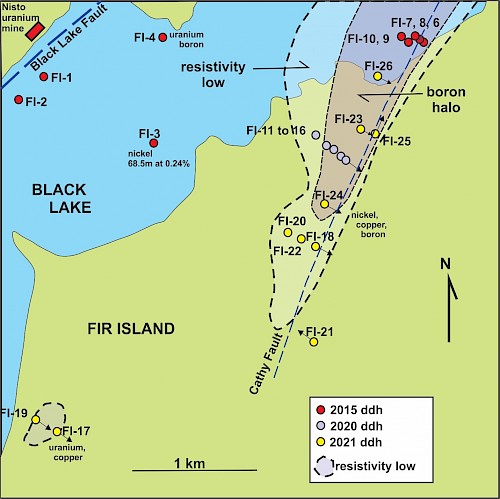| Ownership: | Orano Canada Inc. 51% / Forum 49% |
| Stage: | Highly Prospective; Drill ready |
| Size: | 20,463 ha |
| Location & Infrastructure |
Fir Island is located approximately 5km northeast of the community of Black Lake, on the northeast edge of the Athabasca Basin. It is connected by an all-weather road to the provincial highway system, which also provides year-round road access to the Rabbit Lake and McClean Lake mills. The property can be accessed by truck in the winter and by boat in the summer. |
| Regional Significance |
The regionally important Black Lake fault, part of the major Snowbird Tectonic Zone, transects the entire Athabasca Basin, and is highly prospective for unconformity-type uranium deposits. Cameco’s Centennial deposit is located along this Zone near the south side of the Athabasca Basin. The sandstone cover on the Fir Island project varies from 0 to 200m above the unconformity. The possibility of uranium mineralization below the unconformity at the base of the thrust fault (similar to McArthur River) or in the hanging wall of the Cathy Fault in the basement (similar to Millennium or Eagle Point) demonstrates the highly prospective nature of the Fir Island project. |
| Proximity to significant deposits |
The historic Nisto uranium mine (96 tonnes mined at 1.38% in the late 1950s) occurs in basement rocks on the northwest side of the Black Lake fault, directly adjacent to the property. The project is within driving distance of the McClean Lake mill, operated by Orano Canada Ltd. |
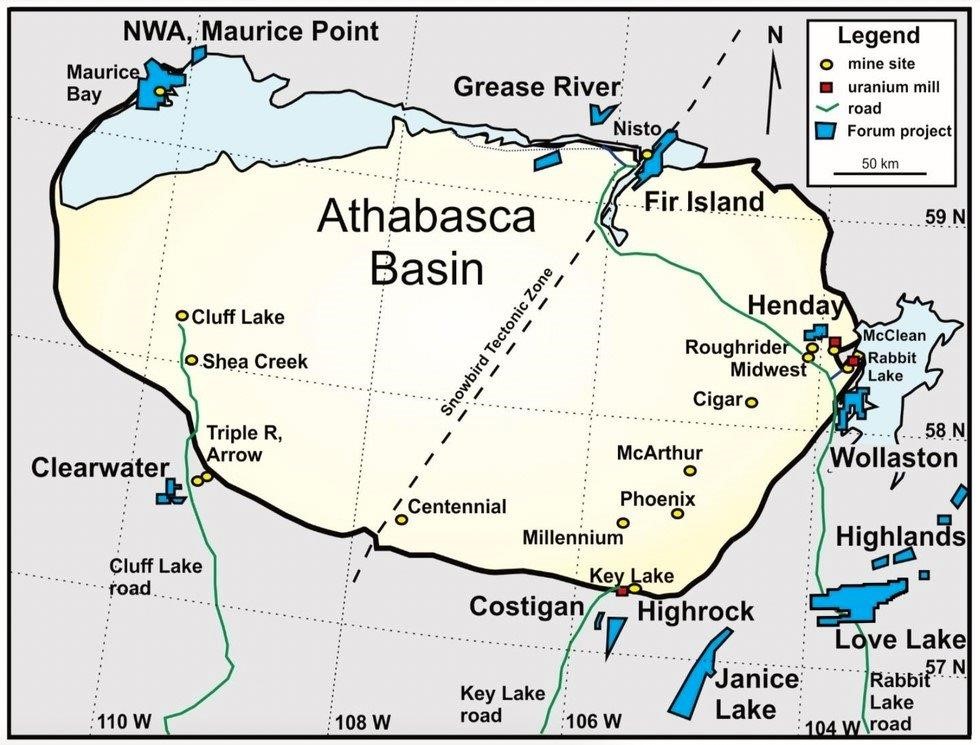
Fir Island Project Location Map. An all-weather road is present within 3km of the property and connects with the McClean Lake and Rabbit Lake uranium mills
Outlook
Forum is the exploration operator now that Orano has earned a 51% interest in the project. Future winter drilling is dependent on a new budget agreement.
2021-2022 Programs
In April 2021, Forum completed ten holes for 3,051m. Eight holes tested the Cathy Fault /resistivity anomaly, while the remaining two holes tested a smaller nearby resistivity low to the southwest. A 100m interval of interpreted ultramafic rock with elevated nickel was intersected in the basement rocks in Hole FI-24. This same lithology with 0.24% nickel over a 68.5m interval has been identified in Hole FI-3, located 1.1km west of FI-24.
Drill targets have been identified along a four kilometre electromagnetic conductor marking the Cathy Fault to the north of Fir Island after Orano completed a resistivity survey in 2022.

Summer 2022 Resistivity Survey Area
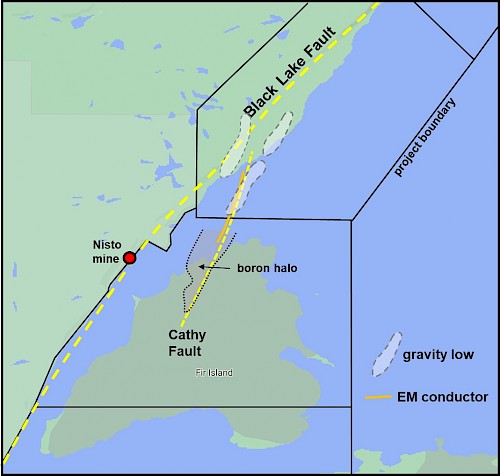
Untested 2021 drill target area due to mild winter conditions
Historical Work
- Forum completed a 10 hole reconnaissance drill program totaling 2,435m in early 2015, the first drill holes completed on this project. Drill hole FI-03 intersected 35m of 0.3% nickel from 180m to 215m in the basement lithologies. Drill hole FI-04 intersected up to 386ppm U in clay-rich basement lithologies immediately beneath the unconformity at 140m, and then 17m of enriched boron (up to 2810ppm) from 148m to 165m depth.
- Five holes were competed on two fences 50m apart ( See Target H on Figure 3) and intersected a very interesting area of tectonization, quartz dissolution, and a 50m offset in the unconformity along a NE trending thrust fault (Cathy Fault -See Figure 3). Dravite and sudoite clays were found in both the sandstone and basement lithologies, along with locally elevated geochemistry (U, Pb, B). Hole FI-8, drilled near the East Channel Structure, returned values of 137 and 161ppm U respectively, below a section of 16m of 2750ppm B, all within pegmatites starting at depth of 202m to the unconformity.
- Ground gravity surveys over the west channel (2015) and on the island (2016) have been completed. This was followed by a soil sampling program looking for anomalous indicator elements down-ice from the gravity lows. Very anomalous boron values were returned from several of the lows (Figure 3).
- In 2019 a resistivity survey was completed over the East Channel (located on the island) and showed a strong low interpreted to be due to alteration / tectonics on the north-west side (Figure 5).
- A 6-hole diamond drill program in 2020 completed one fence approximately 1km south of the 2015 drilling. The Cathy Fault was once again intersected, along with elevated geochemistry, strong alteration and tectonics and a 40m offset in the unconformity. The program was terminated early due to the initial Covid-19 outbreak.
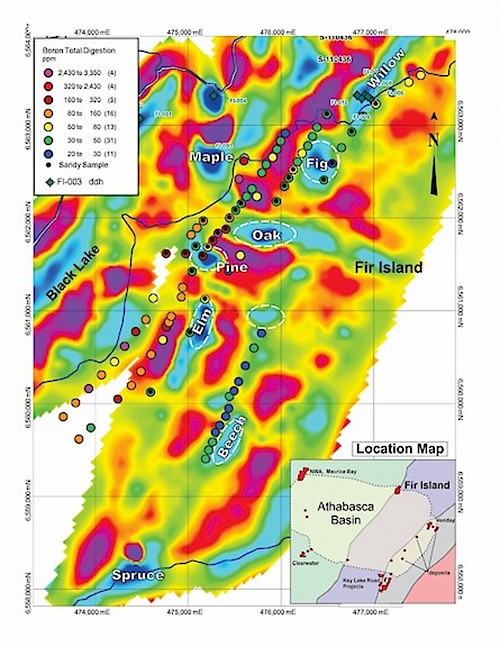
Figure 3: 2014 and 2016 Filtered Gravity Survey with Boron Geochemistry from Soil Samples

Figure 4: Cross-Section FI-9, 10. The extent of the Cathy fault into the basement rocks is not known. Blue lines are dravite intersections, triangles area tectonics.

Figure 5: 2020 Drill Cross Section. The Cathy Fault appears to be steepening and may occur as a series of steps.
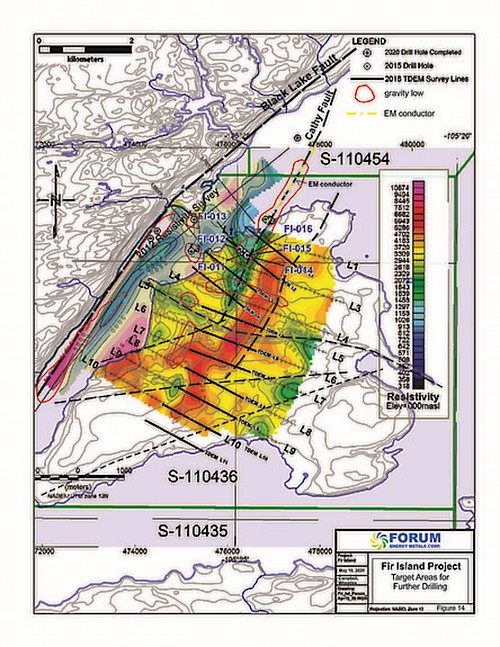
Figure 6: Resistivity Survey (2019) with Drill Hole Locations (2020) and Gravity Lows. Gravity lows are outlined in red, green colours represent the resistivity lows and dashed lines are interpreted faults.

